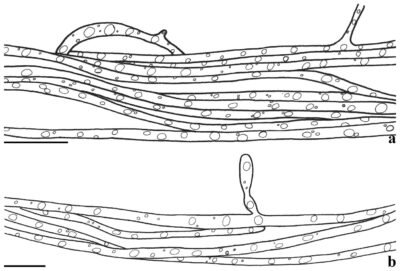Fungalpedia – Note 390, Soosiella
Soosiella Hujslová & M. Kolařík
Citation when using this data: Tibpromma et al. 2024 (in prep.) – Fungalpedia, Ascomycota.
Index Fungorum, Facesoffungi, MycoBank, GenBank, Fig. 1
Classification: Hyphodiscaceae, Helotiales, Leotiomycetidae, Leotiomycetes, Pezizomycotina, Ascomycota, Fungi.
The multigene phylogenetic analysis of ribosomal DNA sequences (ITS region, SSU, LSU) belonging to different phylogenetic lineages in Sordariomycetes and Leotiomycetes (Pezizomycotina, Ascomycota) by Hujslová et al. (2014) revealed that Soosiella typified with Soosiella minima, the only species belonging to the genus. On acidic medium, Soosiella minima produces Mycelium sterile, 2.5–4.0 μm wide, sparsely branched, irregularly granular. The phylogenetic placement of Soosiella is doubtful based on ITS, SSU, and LSU phylogenies. However, the phenotypic characteristics of acidotolerance support this genus. Soosiella was introduced based on the asexual morph in Leotiomycetes (Pezizomycotina, Ascomycota), but the sexual morph is unknown. Soosiella is acidotolerant in soil. However, Soosiella relied on Hyphodiscaceae in a phylogenetic study by Quijada et al. (2022). This was also observed by Johnston et al. (2019). Although Soosiella and Hyphopeziza form sister clades in Hyphodiscaceae, due to the presence of yeast-like colonies, Soosiella was identified as a stable genus within Hyphodiscaceae.
Type species: Soosiella minima Hujslová & M. Kolařík
Other accepted species: This genus is monotypic.
Figure 1 –Soosiella minima. a, b Sterile mycelium fully filled with granules;. Scale bars: a, b = 10 μm. Redraw from Hujslová et al. (2014).
References
Entry by
Karunarathna A, Department of Entomology and Plant Pathology, Faculty of Agriculture, Chiang Mai University, Chiang Mai 50200, Thailand.
(Edited by Saowaluck Tibpromma, Samaneh Chaharmiri-Dokhaharani, & Achala R. Rathnayaka)
Published online 26 November 2024
